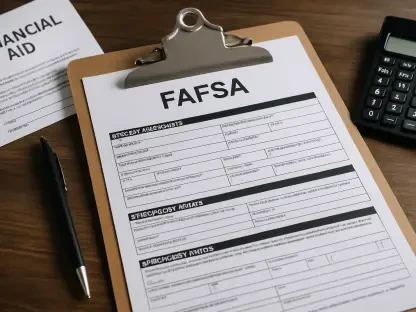Higher education often promises a pathway to opportunity, yet for many low-income students, this path remains obstructed by systemic barriers that hinder access and success. A staggering statistic reveals that less than 6% of four-year colleges in the United States qualify as “equity engines”—institutions where at least 34% of students receive Pell Grants and 55% of those students graduate within six years. This alarming scarcity raises critical questions about access and success for disadvantaged populations. This roundup brings together diverse perspectives from higher education experts, researchers, and policy advocates to unpack why so few colleges effectively serve low-income students, highlight successful models, and explore potential solutions to bridge this equity gap.
Understanding the Equity Gap in College Access and Completion
Defining Equity Engines and Their Rarity
The concept of equity engines has emerged as a benchmark for assessing how well colleges support low-income students, specifically Pell Grant recipients. These institutions are defined by their ability to enroll a significant proportion of such students while ensuring a majority graduate within a reasonable timeframe. Despite the clear need for such schools, data indicates that only 91 out of over 1,500 studied four-year colleges meet these criteria. This rarity underscores a profound disparity in higher education, leaving many students without viable options for supportive learning environments.
Experts in the field have expressed concern over the limited number of these institutions, pointing out that their scarcity restricts opportunities for economic mobility. Many low-income students are forced to attend colleges with lower graduation rates or forgo higher education altogether due to a lack of accessible equity engines. The consensus among analysts is that this gap represents a systemic failure to prioritize the needs of disadvantaged groups, prompting calls for urgent reform.
A further layer of complexity arises when considering the uneven distribution of these colleges across the nation. With equity engines present in only 26 states, large swaths of the country, particularly in high-poverty regions, lack access to such transformative institutions. This geographic imbalance has been described by researchers as a form of spatial injustice, amplifying the challenges faced by students in underserved areas.
Perspectives on Systemic Barriers
Various stakeholders in higher education attribute the scarcity of equity engines to a combination of funding shortages and institutional priorities. Some argue that many colleges, especially those in under-resourced regions, lack the financial capacity to implement robust support systems for low-income students. This viewpoint suggests that without significant investment, these schools struggle to offer the necessary academic and personal resources to boost graduation rates.
Others contend that the issue stems from a deeper cultural problem within academia, where the focus often lies on prestige or selectivity rather than inclusivity. Advocates for change emphasize that many institutions have not adapted their missions to address the unique needs of Pell Grant recipients, such as flexible scheduling or financial aid navigation. This perspective highlights the need for a shift in mindset among college leaders to prioritize equity over traditional metrics of success.
A third angle comes from policy analysts who stress the role of state and federal governments in perpetuating these disparities. They note that inconsistent funding models and a lack of accountability measures for student outcomes contribute to the problem. There is a growing push among these experts for policies that incentivize colleges to improve access and completion rates for disadvantaged populations, signaling a need for systemic overhaul.
Models of Success and Geographic Challenges
Diverse Approaches to Supporting Low-Income Students
Despite the overall scarcity, the few colleges identified as equity engines showcase a variety of successful models. These institutions range from regional public universities to small religious colleges and historically Black colleges and universities (HBCUs), demonstrating that there is no one-size-fits-all approach to fostering student success. This diversity suggests that multiple strategies can be effective when tailored to specific student demographics and institutional strengths.
One commonly cited example is a public university in a major urban area that achieves a 58% six-year graduation rate for Pell Grant students. Experts attribute this success to targeted initiatives like evening courses and transportation assistance, which address practical barriers faced by low-income learners. Such practical measures have been praised as replicable solutions that other colleges could adopt to enhance their support systems.
However, identifying the precise factors behind these outcomes remains a challenge. Researchers in the field caution that while certain practices stand out, the interplay of campus culture, leadership commitment, and community partnerships also plays a crucial role. Ongoing studies aim to dissect these elements further, with hopes of providing a clearer roadmap for other institutions striving to become equity engines.
Addressing Spatial Injustice in Higher Education
The geographic distribution of equity engines reveals a stark divide, with nearly half of the United States lacking a single such institution. This imbalance creates significant hurdles for students in rural or high-poverty areas who must either relocate or settle for less supportive colleges. Experts describe this disparity as a critical barrier to educational equity, urging targeted interventions to address regional gaps.
Some policy advocates propose that state governments invest in colleges close to achieving equity engine status, particularly those in underserved regions. While this idea has gained traction, complications arise since many potential candidates are private institutions, limiting the scope of public funding. This dilemma has sparked debates about how to balance state resources with the autonomy of private colleges in tackling spatial disparities.
Beyond financial solutions, there is a call for cultural and organizational changes within higher education systems to prioritize geographic equity. Analysts suggest that fostering collaborations between states and institutions could help spread best practices and resources more evenly. Such cooperative efforts, though complex, are seen as essential to ensuring that no region is left without access to colleges that champion low-income student success.
Measuring Success Beyond Graduation Rates
Economic Mobility as a Key Metric
While high graduation rates are a hallmark of equity engines, many experts argue that the conversation must extend to post-graduation outcomes. There is growing recognition that a degree’s value depends heavily on the economic mobility it provides, with significant variations across institutions. This perspective emphasizes that true equity in higher education must include pathways to financial stability for graduates.
Data comparisons reveal that identical degrees from different colleges can yield vastly different earnings potential for alumni. Industry leaders in higher education policy stress that this discrepancy highlights the need for colleges to focus not only on completion but also on preparing students for lucrative careers. Such insights are pushing institutions to integrate career services and industry connections into their support frameworks for low-income students.
Looking ahead, there is speculation about how equity engines can sustain their impact if graduates struggle to achieve meaningful economic advancement. Some researchers advocate for longitudinal studies to track alumni outcomes over time, providing a clearer picture of long-term success. This evolving discussion underscores that the mission of equity in higher education must encompass both academic and financial achievements.
Strategies for Systemic Improvement
Drawing from the successes of existing equity engines, several actionable strategies have emerged to bolster support for low-income students. State investments in near-equity institutions are frequently recommended, alongside the adoption of proven practices such as flexible course scheduling and comprehensive advising. These measures are seen as practical steps toward expanding the number of colleges that effectively serve Pell Grant recipients.
Another key insight from experts is the importance of prioritizing economic outcomes alongside graduation metrics. Colleges are encouraged to forge stronger partnerships with local employers and offer robust internship programs to enhance job readiness. This dual focus on completion and career preparation is viewed as a critical component of transforming higher education into a true engine of equity.
Community engagement also plays a pivotal role in this vision, with advocates urging local stakeholders to support colleges in their efforts to prioritize disadvantaged students. Whether through policy initiatives or grassroots campaigns, building a collective commitment to equity is deemed essential. This multifaceted approach reflects the complexity of the issue and the need for collaboration across various sectors.
Reflecting on Insights and Charting the Next Steps
Looking back on the discussions captured in this roundup, it is evident that the scarcity of equity engines in higher education poses a significant challenge to low-income students seeking opportunity. The diverse perspectives from experts illuminated the systemic barriers, geographic disparities, and varied models of success that shape this landscape. The emphasis on economic mobility alongside graduation rates added depth to the conversation, highlighting that true equity demands more than just a diploma.
Moving forward, actionable steps emerged as a priority for stakeholders at all levels. Colleges are encouraged to adopt tailored support mechanisms, states to invest strategically in underserved regions, and communities to advocate for inclusive policies. Additionally, the push for comprehensive data on post-graduation outcomes suggests a new frontier for research and accountability. These steps, grounded in the insights shared, offer a promising direction for dismantling barriers and building a more equitable higher education system.









